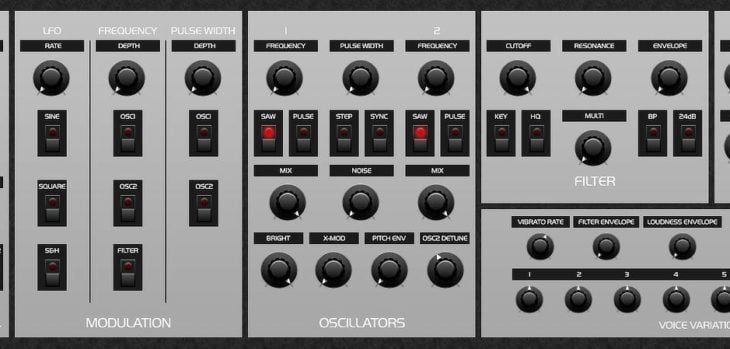discoDSP has announced that they have taken over development on the OB-Xd software emulation of the Oberheim OB-X, OB-Xa and OB8, which has been a work in progress for the last three years on the KVR forum, but now that its original creator, known only as “2DaT”, has given the project to discoDSP, version 1.3 has officially been made available on their website linked below.
See also: OBXD – Free Oberheim OB-X Emulation VSTi Plugin Released By 2DaTOB-Xd hasn’t changed much in the last few years in terms of its overall design, though significant chances have been made to the source code throughout the beta phase and the discoDSP version loads up with a more modern skin, though I’m sure Oberheim purists might prefer the black and blue pin-striped GUI.
Don’t worry, the controls are exactly the same as before, even though the new GUI has slightly moved things around a bit. The master volume and tuning controls, along with options for MIDI learn and voice handling, can be found within the global “Manual” section.
Portamento, pitch-bend range up to a whole octave and as much as eight unison voices (mono only) with a stereo spread control are available in the “Control” section, next to the “Modulation” section, where you have a global rate control, optional sine, square and sample & hold waveforms (or a combination thereof) and two separate depth controls with independent routing for each of the two oscillators and filter cutoff.
In the “Oscillators” section, there are controls for oscillator frequency in hertz (even though the knob reads out a linear scale of 0-100), pulse width modulation for optional/additional pulse wave, and a small handful of controls for oscillator mix, a cross-modulation multiplier, oscillator detune, white noise, a pitch envelope routed to the filter envelope and a brightness control for adjusting clarity of higher harmonics.
In the “Filter” section there are intuitive controls for a “juicy” 12dB/octave resonant low-pass filter with an optional 24dB slope, and a “Multi” control that fades between lowpass behavior on the left, to either notch (by default) or bandpass (if “BP” switch is selected) behavior at fifty percent, to high-pass behavior on the right. Also, there are options for keytracking the filter frequency cutoff and “High Quality” mode.
Both the filter and amplitude envelopes are basic ADSR envelopes, so there’s no mystery there, but I must draw attention to the “Voice Variation” section, where you can fine tune the stereo panning of each of the eight voices available in the voice handling window, velocity sensitivity for both envelopes, and a simple depth control for mod-wheel to vibrato sensitivity, which you can also turn down completely.
This isn’t just one of the best freeware emulations of Oberheim’s early polyphonic synthesizers; OB-Xd is also one of the best virtual analogue synths available on the freeware market, with the same fullness and warmth you would expect from any classic analogue synthesizer.
OB-Xd is available for free download via discoDSP (Mac version 11.5 MB download size, ZIP archive, VST plugin format for Mac OS X / Windows version 6.64 MB download size, ZIP archive, both 32 & 64-bit VST plugin format for Windows).



16 Comments
UberHeinie
onThank goodness for the optional skin, the default doesn’t even fit on my 1600×900 laptop! Sounds great though.
JoeHF
onAgreed, that blue skin is just gargantuan. (Not everyone uses Retina displays; I know, crazy talk!) But it sure is purrrdy…
Esol
onOh great! So there is no difference between this and 2Dat’s version?
Im going to test this one out after work. :)
Bryan Lake
onAs far as I can tell, there is no difference…so far. DiscoDSP has just taken over the project.
Esol
onAh, thanks. :)
Aesthete
onGeorge is also going to look at the older version 1.1.2 code and why some of us think that sounds better than V1.3.
Brenjamin
onNot sure what I’m doing wrong but I just can’t get the skin to change to the “classic” one. I followed the simple directions in the .txt file but it isn’t working. I could live with the looks of the bland grey GUI, but it’s to wide omy screen unlike the “classic” skin which is the perfect length and height – plus I much prefer the original skin to either of the new ones. Anyone out there who can offer some assistance please? Thanks in advance
Wasyl
onSame here.
Stu
onCreate a folder named OB-Xd, put that folder in your documents folder (C:\Users\*Username*\Documents), and then place the ‘Classic’ folder inside that.
BMXBigMac
onIs there a way to load patches into the OB-Xd in Ableton Live?
BMXBigMac
onThink I found a way.
Atme
onAwesome quality freebie synth! Amazing!
Atme
onIt is so refreshing to know the development of OBXD is still alive! I hope 2Dat/Datsounds will return with an updated sound engine of OBXD! The oscillator waveforms could be more sonically consistent and maybe a tad bit more fat and punchy.
Atme
onHmmm… The comments are not working as normal. I have to post a second comment for the first one to be seen and a third one for the second one to be seen. Very strange.
Tomislav Zlatic
onThe comments are moderated before publishing to prevent spammers from posting. Sorry for the delay when posting new comments!
Atme
onOk. No problem. =)